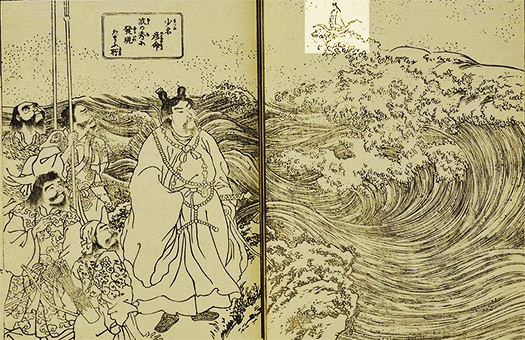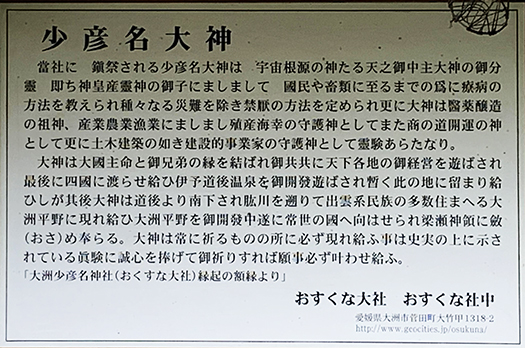


昨日はチョー暴風雪到来でブログテーマは1日順延しましたが、
北海道神宮の「開拓三神」のひとつ、個性派「少彦名」さんについての続篇。
いちばん上はWikipediaのこの項のページにある神話伝承イラスト。
どうも江戸期に描かれたもののようで、少彦名の縁起を表現したもの。
大きく描かれている人物は大国主命で、その国づくりに際して
画面右上に「波に乗って現れた」少彦名さんが手助けにやってきた、という故事。
一方その下の写真は現在の「拝殿」と神社の縁起プレート板。
とくに縁起プレートには面白い記述があって興味深い。
それは「道後より南下され出雲系民族の多数住まへる大洲平野に現れ給い」
という記述部分であります。
この社伝では少彦名さんは道後温泉を発見して開いたりしている。
そして「療病の方法を教えられ」という記述もある。
古代史を見ていると、奈良の都で疫病パンデミックが猖獗したとき、
聖武天皇の后、光明子は現代で言うサウナ風呂を救世施設として造営している。
日本の医療、疫病対応として入浴の習慣というのは、
どうも始原期からの伝統的な行為だったように思われるのです。
神代の時代にすでに「道後温泉」を開いて療病の神さまになったという故事は
大変示唆的なのではないでしょうか。
そして医薬と醸造の神さまともされている。
お酒というものが始原期においては薬効あらたかなものとされたこともあって、
そのような神格として祀られてきた故事が浮かんでくる。
温泉を開発するには当然「土木建築」の手法開発も必然でしょう。
こういった伝承から少彦名の「事跡」が事実痕跡として見えてくる。
そしてやはり「出雲系民族」多数居住という解説が興味深い。
大国主の協力者として出雲系民族のNO.2と擬せられていた存在。
そして「海を渡って現れた」という伝承から推測すれば、
もともと南予地域に出雲から分枝した民族系統の一族であって
大国主命が国づくりという「統一事業」を発起したとき、
その一族の人間として南予地域をまとめて協力した、というようにとれる。
当然、瀬戸内海を渡って南予から出雲支配地域に「現れた」だろう。
神話ファンタジーの世界の表現だけれど、どうも歴史に書かれなかった
事実の痕跡を垣間見ることができるのではないか。
出雲系統はその後、国譲りしてヤマト朝廷に政権を譲渡するけれど、
ヤマト朝廷側でも、出雲系統の神々にはリスペクトを見せて
はるかな後世、あらたな国土としての北海道開拓経営に当たって
この大国主命と少彦名命を一宮、北海道神宮の神として祀った。
必ずしも歴史事実そのままではないだろうし検証しようもないけれど、
この少彦名命との偶然の出会いはたいへん民俗心を刺激してくれます。
English version⬇
[Mythical fantasy and traces of facts Sukunahikona Shrine-2]
Yesterday, the blog theme was postponed for one day due to the arrival of the Cho blizzard,
A sequel to one of the “Pioneering Three Gods” of Hokkaido Jingu Shrine, the individuality group “Sukuna bi kona”.
At the top is the mythological folklore illustration on this section of Wikipedia.
It seems that it was drawn in the Edo period, and it expresses the auspices of Sukunahikona.
The person depicted in large size is Okuninushi, and when creating that country
The fact that Mr. Sukuna, who “appeared on the waves” came to help in the upper right corner of the screen.
On the other hand, the photo below is the current “haiden” and the auspicious plate of the shrine.
Especially the auspicious plate has an interesting description and is interesting.
It “appears in the Ozu Plain, where many Izumo ethnic groups live south of Dogo.”
It is the description part.
In this company biography, Mr. Shohikona discovers and opens Dogo Onsen.
And there is also a description that “tell me how to treat the disease”.
Looking at ancient history, when the plague pandemic broke out in the city of Nara,
After Emperor Shomu, Komyoko built a modern-day sauna bath as a salvation facility.
The habit of bathing as a medical treatment and plague response in Japan is
It seems that it was a traditional act from the early days.
The fact that he had already opened “Dogo Onsen” in the age of the Gods and became a god of medical treatment
Isn’t it very suggestive?
It is also known as the god of medicine and brewing.
Alcohol was considered to have a new medicinal effect in the early days, so
The story that has been enshrined as such a deity comes to mind.
Of course, in order to develop a hot spring, it is inevitable to develop a method of “civil engineering”.
From these traditions, the “trace” of Sukunahikona can be seen as a factual trace.
And after all, the commentary that many “Izumo ethnic groups” live is interesting.
Existence that was imitated as No. 2 of the Izumo people as a collaborator of Okuninushi.
And if you guess from the folklore that “appeared across the sea”
Originally a clan of ethnic lineage branched from Izumo in the Nanyo area
When Okuninushi started a “unified project” called nation-building
It can be said that they cooperated with the Nanyo region as a human being of the clan.
Naturally, it would have “appeared” in the Izumo-controlled area from Nanyo across the Seto Inland Sea.
It’s an expression of the world of mythical fantasy, but it wasn’t written in history.
You can get a glimpse of the traces of the facts.
After that, the Izumo system transferred the government to the Yamato court, but
Even on the Yamato court side, show respect to the gods of the Izumo system
In the distant future, in the management of Hokkaido development as a new land
Okuninushi and Sukuna bi kona were enshrined as the gods of Ichinomiya and Hokkaido Jingu.
It’s not necessarily the historical fact, and I can’t verify it,
This accidental encounter with Sukunahikona is very stimulating to the folk spirit.
Posted on 1月 14th, 2022 by 三木 奎吾
Filed under: 日本社会・文化研究, 歴史探訪







コメントを投稿
「※誹謗中傷や、悪意のある書き込み、営利目的などのコメントを防ぐために、投稿された全てのコメントは一時的に保留されますのでご了承ください。」
You must be logged in to post a comment.